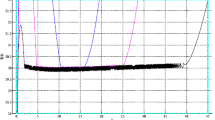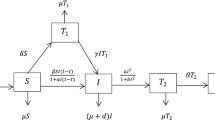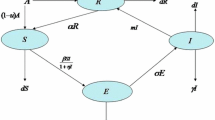Abstract
The control of highly contagious diseases is very important today. In this paper, we proposed an SEIR model with Crowley–Martin-type incidence rate and Holling type II and III treatment rates. Dynamics of the spread of infection and its control are performed for both the cases of treatment functions. We have performed the stability and bifurcation analyses of the model system. The sensitivity analysis of all the parameters with respect to the basic reproduction number has been performed. Furthermore, we discussed the optimal control strategy using Pontryagin’s maximum principle and determined the effect of control parameter u on the model dynamics. Moreover, we validate the theoretical results using numerical simulations. Between both the treatment functions, we observe that the implementation of Holling type II treatment is most effective to prevent the spread of diseases. Thus, we conclude that the pervasive effect of treatment not only reduces the basic reproduction number as the control parameter u increases with nonlinear treatment, h(I) but also controls the spread of disease infection among the population.









Similar content being viewed by others
References
Ackleh, A.S., Allen, L.J.: Competitive exclusion and coexistence for pathogens in an epidemic model with variable population size. J. Math. Biol. 47(2), 153–168 (2003)
Anderson, R.M., May, R.M.: Regulation and stability of host-parasite population interactions: I. Regulatory processes. J. Anim. Ecol. 47, 219–247 (1978)
Anderson, R.M., May, R.M.: Infectious Diseases of Humans: Dynamics and Control. Oxford University Press, New York (1992)
Arino, J., McCluskey, C.C., van den Driessche, P.: Global results for an epidemic model with vaccination that exhibits backward bifurcation. SIAM J. Appl. Math. 64(1), 260–276 (2003)
Bai, Z., Zhou, Y.: Global dynamics of an SEIRS epidemic model with periodic vaccination and seasonal contact rate. Nonlinear Anal. Real World Appl. 13(3), 1060–1068 (2012)
Bailey, N.T., et al.: The mathematical theory of infectious diseases and its applications. Charles Griffin & Company Ltd, 5a Crendon Street, High Wycombe, Bucks HP13 6LE. (1975)
Binder, S., Levitt, A.M., Sacks, J.J., Hughes, J.M.: Emerging infectious diseases: public health issues for the 21st century. Science 284(5418), 1311–1313 (1999)
Biswas, S., Sasmal, S.K., Samanta, S., Saifuddin, M., Pal, N., Chattopadhyay, J.: Optimal harvesting and complex dynamics in a delayed eco-epidemiological model with weak Allee effects. Nonlinear Dyn. 87(3), 1553–1573 (2017)
Blower, S.M., McLean, A.R.: Mixing ecology and epidemiology. Proc. R. Soc. Lond. B 245(1314), 187–192 (1991)
Bowong, S., Kurths, J.: Modeling and analysis of the transmission dynamics of tuberculosis without and with seasonality. Nonlinear Dyn. 67(3), 2027–2051 (2012)
Castillo-Chavez, C., Song, B.: Dynamical models of tuberculosis and their applications. Math. Biosci. Eng. 1(2), 361–404 (2004)
Chen, Q., Teng, Z., Wang, L., Jiang, H.: The existence of codimension-two bifurcation in a discrete SIS epidemic model with standard incidence. Nonlinear Dyn. 71(1–2), 55–73 (2013)
Crowley, P.H., Martin, E.K.: Functional responses and interference within and between year classes of a dragonfly population. J. North Am. Benthol. Soc. 8(3), 211–221 (1989)
Diaz, P., Constantine, P., Kalmbach, K., Jones, E., Pankavich, S.: A modified SEIR model for the spread of Ebola in Western Africa and metrics for resource allocation. Appl. Math. Comput. 324, 141–155 (2018)
Van den Driessche, P., Watmough, J.: Reproduction numbers and sub-threshold endemic equilibria for compartmental models of disease transmission. Math. Biosci. 180(1–2), 29–48 (2002)
Dubey, B., Dubey, P., Dubey, U.S.: Dynamics of an SIR model with nonlinear incidence and treatment rate. Appl. Appl. Math. 10(2), (2015)
Dubey, B., Patra, A., Srivastava, P., Dubey, U.S.: Modeling and analysis of an SEIR model with different types of nonlinear treatment rates. J. Biol. Syst. 21(03), 1350023 (2013)
Dubey, P., Dubey, B., Dubey, U.S.: An SIR model with nonlinear incidence rate and Holling type III treatment rate. Appl. Anal. Biol. Phys. Sci. 186, 63–81 (2016)
Earn, D.J., Rohani, P., Bolker, B.M., Grenfell, B.T.: A simple model for complex dynamical transitions in epidemics. Science 287(5453), 667–670 (2000)
Elaiw, A., Azoz, S.: Global properties of a class of HIV infection models with Beddington-DeAngelis functional response. Math. Methods Appl. Sci. 36(4), 383–394 (2013)
Elbasha, E., Podder, C., Gumel, A.: Analyzing the dynamics of an SIRS vaccination model with waning natural and vaccine-induced immunity. Nonlinear Anal. Real World Appl. 12(5), 2692–2705 (2011)
Feng, Z., Thieme, H.R.: Recurrent outbreaks of childhood diseases revisited: the impact of isolation. Math. Biosci. 128(1–2), 93–130 (1995)
Hu, Z., Liu, S., Wang, H.: Backward bifurcation of an epidemic model with standard incidence rate and treatment rate. Nonlinear Anal. Real World Appl. 9(5), 2302–2312 (2008)
Hutson, V., Schmitt, K.: Permanence and the dynamics of biological systems. Math. Biosci. 111(1), 1–71 (1992)
Hyman, J.M., Li, J.: Modeling the effectiveness of isolation strategies in preventing STD epidemics. SIAM J. Appl. Math. 58(3), 912–925 (1998)
Jana, S., Nandi, S.K., Kar, T.: Complex dynamics of an SIR epidemic model with saturated incidence rate and treatment. Acta Biotheor. 64(1), 65–84 (2016)
Kar, T., Batabyal, A., Agarwal, R.: Modeling and analysis of an epidemic model with classical Kermack–Mckendrick incidence rate under treatment. J. Korea Soc. Ind. Appl. Math. 14(1), 1–16 (2010)
Keeling, M.J., Woolhouse, M.E., Shaw, D.J., Matthews, L., Chase-Topping, M., Haydon, D.T., Cornell, S.J., Kappey, J., Wilesmith, J., Grenfell, B.T.: Dynamics of the 2001 UK foot and mouth epidemic: stochastic dispersal in a heterogeneous landscape. Science 294(5543), 813–817 (2001)
Kermack, W.O., McKendrick, A.G.: A contribution to the mathematical theory of epidemics. Proc. R. Soc. Lond. A 115(772), 700–721 (1927)
Khan, M.A., Khan, Y., Islam, S.: Complex dynamics of an SEIR epidemic model with saturated incidence rate and treatment. Phys. A Stat. Mech. Appl. 493, 210–227 (2018)
Koprivica, V., Stone, D.L., Park, J.K., Callahan, M., Frisch, A., Cohen, I.J., Tayebi, N., Sidransky, E.: Analysis and classification of 304 mutant alleles in patients with type 1 and type 3 Gaucher disease. Am. J. Human Genet. 66(6), 1777–1786 (2000)
Lekone, P.E., Finkenstädt, B.F.: Statistical inference in a stochastic epidemic SEIR model with control intervention: Ebola as a case study. Biometrics 62(4), 1170–1177 (2006)
Li, L.: Patch invasion in a spatial epidemic model. Appl. Math. Comput. 258, 342–349 (2015)
Li, L.: Monthly periodic outbreak of hemorrhagic fever with renal syndrome in China. J. Biol. Syst. 24(04), 519–533 (2016)
Li, L., Bai, Y., Jin, Z.: Periodic solutions of an epidemic model with saturated treatment. Nonlinear Dyn. 76(2), 1099–1108 (2014)
Li, L., Zhang, J., Liu, C., Zhang, H.T., Wang, Y., Wang, Z.: Analysis of transmission dynamics for Zika virus on networks. Appl. Math. Comput. 347, 566–577 (2019)
Li, M.Y., Muldowney, J.S.: A geometric approach to global-stability problems. SIAM J. Math. Anal. 27(4), 1070–1083 (1996)
Li, M.Y., Wang, L.: A criterion for stability of matrices. J. Math. Anal. Appl. 225(1), 249–264 (1998)
Li, X., Jusup, M., Wang, Z., Li, H., Shi, L., Podobnik, B., Stanley, H.E., Havlin, S., Boccaletti, S.: Punishment diminishes the benefits of network reciprocity in social dilemma experiments. Proc. Natl. Acad. Sci. 115(1), 30–35 (2018)
Martin Jr., R.H.: Logarithmic norms and projections applied to linear differential systems. J. Math. Anal. Appl. 45(2), 432–454 (1974)
May, R.M., Anderson, R.M.: Regulation and stability of host-parasite population interactions: II. Destabilizing processes. J. Anim. Ecol. pp. 249–267 (1978)
McCluskey, C.C.: Global stability for an SIR epidemic model with delay and nonlinear incidence. Nonlinear Anal. Real World Appl. 11(4), 3106–3109 (2010)
Misra, A., Gupta, A., Venturino, E.: Cholera dynamics with Bacteriophage infection: a mathematical study. Chaos Solitons Fractals 91, 610–621 (2016)
Pontryagin, L.S.: Mathematical theory of optimal processes. Routledge, (1987)
Saltelli, A., Ratto, M., Andres, T., Campolongo, F., Cariboni, J., Gatelli, D., Saisana, M., Tarantola, S.: Global Sensitivity Analysis: The Primer. Wiley, New York (2008)
Shu, H., Fan, D., Wei, J.: Global stability of multi-group SEIR epidemic models with distributed delays and nonlinear transmission. Nonlinear Anal. Real World Appl. 13(4), 1581–1592 (2012)
Shulgin, B., Stone, L., Agur, Z.: Pulse vaccination strategy in the SIR epidemic model. Bull. Math. Biol. 60(6), 1123–1148 (1998)
Sun, G.Q., Xie, J.H., Huang, S.H., Jin, Z., Li, M.T., Liu, L.: Transmission dynamics of cholera: mathematical modeling and control strategies. Commun. Nonlinear Sci. Numer. Simul. 45, 235–244 (2017)
Sun, G.Q., Zhang, Z.K.: Global stability for a sheep brucellosis model with immigration. Appl. Math. Comput. 246, 336–345 (2014)
Upadhyay, R.K., Kumari, S., Misra, A.: Modeling the virus dynamics in computer network with SVEIR model and nonlinear incident rate. J. Appl. Math. Comput. 54(1–2), 485–509 (2017)
Wang, W.: Backward bifurcation of an epidemic model with treatment. Math. Biosci. 201(1–2), 58–71 (2006)
Wang, W., Ruan, S.: Bifurcations in an epidemic model with constant removal rate of the infectives. J. Math. Anal. Appl. 291(2), 775–793 (2004)
Wang, X., Tao, Y., Song, X.: Global stability of a virus dynamics model with Beddington-DeAngelis incidence rate and CTL immune response. Nonlinear Dyn. 66(4), 825–830 (2011)
Wang, Y., Lim, H.: The global childhood obesity epidemic and the association between socio-economic status and childhood obesity (2012)
Wu, L.I., Feng, Z.: Homoclinic bifurcation in an SIQR model for childhood diseases. J. Differ. Equ. 168(1), 150–167 (2000)
Xu, R.: Global dynamics of an SEIRI epidemiological model with time delay. Appl. Math. Comput. 232, 436–444 (2014)
Xu, R., Ma, Z.: Global stability of a delayed SEIRS epidemic model with saturation incidence rate. Nonlinear Dyn. 61(1–2), 229–239 (2010)
Xu, S.: Global stability of the virus dynamics model with Crowley–Martin functional response. Electron. J. Qual. Theory Differ. Equ. 2012(9), 1–10 (2012)
Yang, H., Wei, J.: Analyzing global stability of a viral model with general incidence rate and cytotoxic T lymphocytes immune response. Nonlinear Dyn. 82(1–2), 713–722 (2015)
Yuan, Z., Ma, Z., Tang, X.: Global stability of a delayed HIV infection model with nonlinear incidence rate. Nonlinear Dyn. 68(1–2), 207–214 (2012)
Zhang, X., Liu, X.: Backward bifurcation of an epidemic model with saturated treatment function. J. Math. Anal. Appl. 348(1), 433–443 (2008)
Zhonghua, Z., Yaohong, S.: Qualitative analysis of a SIR epidemic model with saturated treatment rate. J. Appl. Math. Comput. 34(1–2), 177–194 (2010)
Zhou, L., Fan, M.: Dynamics of an SIR epidemic model with limited medical resources revisited. Nonlinear Anal. Real World Appl. 13(1), 312–324 (2012)
Zhou, T., Zhang, W., Lu, Q.: Bifurcation analysis of an SIS epidemic model with saturated incidence rate and saturated treatment function. Appl. Math. Comput. 226, 288–305 (2014)
Zhou, X., Cui, J.: Analysis of stability and bifurcation for an SEIV epidemic model with vaccination and nonlinear incidence rate. Nonlinear Dyn. 63(4), 639–653 (2011)
Zhou, X., Cui, J.: Global stability of the viral dynamics with Crowley–Martin functional response. Bull. Korean Math. Soc. 48(3), 555–574 (2011)
Acknowledgements
We are thankful to Council of Scientific & Industrial Research (CSIR) India for providing financial support through Project No.- CSIR-25(0277)/17/EMR-II to the first author (RKU).
Author information
Authors and Affiliations
Corresponding author
Ethics declarations
Conflicts of interest
The authors declare that there is no conflict of interests regarding the publication of this article.
Ethical standard
The authors state that this research complies with ethical standards. This research does not involve either human participants or animals.
Additional information
Publisher's Note
Springer Nature remains neutral with regard to jurisdictional claims in published maps and institutional affiliations.
Rights and permissions
About this article
Cite this article
Upadhyay, R.K., Pal, A.K., Kumari, S. et al. Dynamics of an SEIR epidemic model with nonlinear incidence and treatment rates. Nonlinear Dyn 96, 2351–2368 (2019). https://doi.org/10.1007/s11071-019-04926-6
Received:
Accepted:
Published:
Issue Date:
DOI: https://doi.org/10.1007/s11071-019-04926-6




